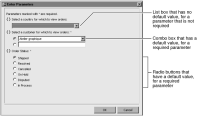Providing the user with a list of values
List boxes, combo boxes, and radio buttons are ideal mechanisms for providing a list of values to a user. The differences between these user interface elements are as follows:

Radio buttons occupy as many lines in the Enter Parameters dialog as there are values. For ease of use, a set of radio buttons should contain fewer than 10 entries.

The list box and combo box appear similar to the user. Both save space in the Enter Parameters dialog. The list box takes up only one line, and the combo box takes up two lines in Enter Parameters. For ease of use, a list box or combo box should contain fewer than 100 values.

In addition to presenting a list of values, the combo box also supports the user typing a value. This feature is useful for supplying a string pattern. For example, instead of selecting a specific name for a customer name parameter, the user can type M% to get all customers whose names start with M. This technique assumes that the user is familiar with SQL pattern-matching syntax.

The list box supports the selection of multiple values. The combo box and radio buttons support the selection of only one value.
Figure 13‑13 shows an example of an Enter Parameters dialog that displays a list box, combo box, and radio buttons.
Figure 13‑13 Three types of selection elements in Enter Parameters
You can create two kinds of lists: static and dynamic.

In a static list of values, you specify the values to display to the report user during report design. Creating a static list provides more control over the list of values. For example, you might want to present only certain values to the user, or localize the values. If you create a static list of values, however, you have to update the list manually to match the values in the data source.

In a dynamic list of values, BIRT retrieves the values from the data source when the report runs. Create a dynamic list for values that are frequently updated in the data source, such as new customer names, product names, or order numbers.
For a list box or a combo box, you can create either a static or a dynamic list of values. For a set of radio buttons, you can only create a static list.
